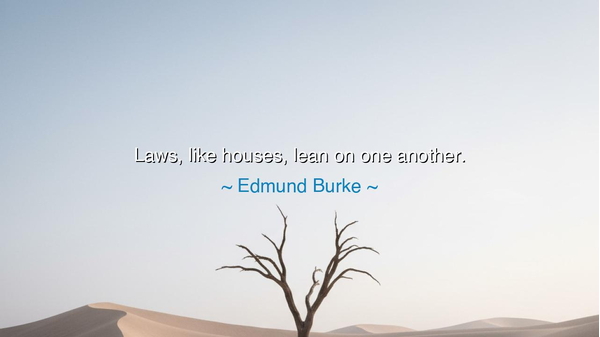
Laws, like houses, lean on one another.






Hear, O seekers of wisdom, the words of Edmund Burke, who declared: “Laws, like houses, lean on one another.” In this brief and mighty saying, there is the wisdom of centuries, for he reveals that the structures of justice and governance, like the structures of stone and wood, are not self-sufficient, but interdependent. No law stands alone, just as no house stands without the walls, beams, and foundation that support it. To forget this truth is to misunderstand the nature of order itself.
The meaning of this utterance lies in the vision of society as an intricate web. Laws do not spring from nothing, nor do they endure in isolation. Each law builds upon those that came before, borrowing authority from precedent and lending strength to what follows. Remove one carelessly, and others may topple; neglect the foundation, and the whole structure may collapse. Burke, who lived through the turbulent era of revolution and reform, knew well that to alter laws without regard for their interdependence was to risk the ruin of the entire system.
The ancients too understood this principle. The Romans, whose legal system became the root of much of Western law, spoke of the “corpus juris”—the body of law. It was not a collection of fragments, but a living body, each part joined to the whole. Just as the arm cannot thrive apart from the body, no single law can be severed from the wider system without consequence. Burke’s metaphor of houses captures this same truth: society’s laws, like dwellings in a crowded city, support one another, lean against one another, and together form the shelter of civilization.
Consider the historical example of the Magna Carta of 1215. At first, it was a narrow agreement between king and barons, but over centuries, it became the cornerstone upon which other laws leaned: the right to trial by jury, the principle of habeas corpus, and the limits on royal authority. If Magna Carta had been dismissed as irrelevant or torn away, the later edifice of liberty could not have been raised. Thus Burke’s words remind us that one law’s worth is not only in itself, but in how it sustains and is sustained by others.
Yet there is also a warning here. For if laws lean on one another, then corruption in one may weaken the whole. A rotten beam can endanger a house; an unjust law can endanger a nation. History bears grim witness: in Nazi Germany, laws were systematically reshaped to strip away rights, each leaning upon the next, until tyranny was given the mask of legality. The house of justice was not destroyed in one blow, but hollowed from within. Burke’s wisdom therefore instructs us: guard the integrity of every law, for its strength sustains the whole edifice.
The lesson for us, then, is profound. When we consider laws, let us not see them as isolated rules but as parts of a larger design. To build wisely, we must strengthen foundations, repair weak beams, and ensure that each new law aligns with the structure already standing. Likewise, when we seek reform, we must not tear down recklessly, but carefully rebuild, knowing that each change will affect the balance of the whole.
Therefore, O listener, take this teaching to heart. In your own life, remember that principles, like laws, lean upon one another. Honesty supports trust, trust supports community, and community supports peace. Remove one, and all suffer. Be diligent, then, in strengthening the small foundations, for upon them rests the greater structure of your life, your family, and your nation.
So let Burke’s words endure as both wisdom and warning: “Laws, like houses, lean on one another.” Build carefully, preserve wisely, and repair faithfully, that the house of justice may endure through the storms of time.






AAdministratorAdministrator
Welcome, honored guests. Please leave a comment, we will respond soon